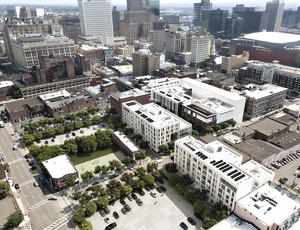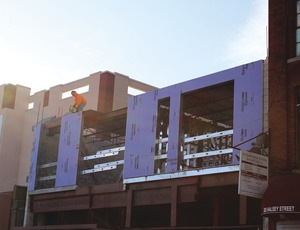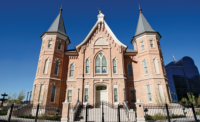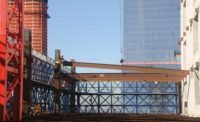A few months after the ribbon was cut on two new schools in Newark, an ambitious multi-block redevelopment project has broken ground with three new apartment buildings intended to house the schools' teachers as well as other city educators.


Called Teachers Village, the mixed-use project in the central business district is part of an ongoing effort to revitalize an impoverished city and, in terms of scope and ambition, it is one of the most significant to date, say project team members. In a densely settled area once lined with parking lots and decrepit warehouses, a mini-neighborhood is being created with low-slung buildings and refurbished sidewalks.
With two out of the six planned buildings completed and three more under way, the $160-million project is coming to life.
"From multiple aspects, this has been successful" because it is providing housing, schools and some infrastructure to a neighborhood in need, says Ron Beit, a managing member of Newark-based developer RBH Group. About 20% of the 410,000-sq-ft project will be dedicated to affordable housing. All told, there will be 213 apartments when it wraps up in 2015.
In September, three schools in two buildings opened at the site. Two of the schools are located at 230 Halsey Street in an ironspot brick and white-steel building from noted architect Richard Meier, a Newark native who designed four of Teachers Village's six window-lined buildings. The other, a block away at 24 Maiden Lane, was designed by KSS Architects, Princeton, N.J., which also designed the interiors for both schools.
Making sure both buildings were ready to open their doors in time for the start of the school year was a challenge, says Doug Phelps, president of Phelps Construction Group, Boonton, N.J., the general contractor on both structures. "This is not like with an office building," Phelps says. "You can't be late. It's a hard date that you've got to meet. " He adds that the buildings actually had to be ready in August to allow the schools time to set up.
The projects, which broke ground in the first half of 2012, had to contend with Superstorm Sandy. While the storm didn't swamp this part of Newark, which sits a few blocks from the Prudential Center arena, it did interrupt the project by pulling away utility workers who were tying the buildings into existing lines. They had to lay down their tools for a few months on this project to assist in the rebuilding effort in damaged parts of the state, Phelps says.
As a result, Phelps' crew had to string up temporary lights. Throughout the winter, they stayed warm using dozens of portable heaters. The utility companies did eventually finish the job, but it happened just weeks before the project was to be completed.
Logistics also proved challenging on that part of the project as well as on current work, which is focused on four mixed-use buildings. Throughout the three-year project, workers must keep surrounding streets open to traffic, including Halsey Street, which is narrow and busy, Phelps says. This means that deliveries must be scheduled all at once and at 5 a.m., instead of starting at the more typical 7 a.m. and spread throughout the day.
If trucks arrived in the afternoon, they could stop for only 10 minutes and required a police officer to temporarily halt traffic, a rule that also applies to Hollister Construction Services, the Parsippany, N.J., general contractor on all three of the mixed-use residential-and-retail buildings now under construction.
To speed the process, a dozen workers were assigned to unload trucks, compared with just a few in more conventional situations. "It was not like a normal job where you have a parking lot," Phelps says.
With school in full swing, attention now is directed toward housing for teachers and related professionals with the goal of forming a tight-knit, secure and professional community. Of the three mixed-use structures under way, the six-story 35 Maiden Lane building is the first, with completion set for next month, Beit says. This 21-unit structure will have wood floors, porcelain tile baths and quartz counters—finishes used in all of the apartments.
Next out of the gate will be 42 William Street, with 40 units, to be completed this summer. The 60-unit 245 Halsey building will open in October, Beit says.
The last building, 17 William Street, was still out to bid at press time, with a team set to be assembled by February. Current plans call for this project to include 90 units in a four-story structure. Originally, plans called for converting the existing nine-story cast-in-place concrete Calumet Building, a historic structure, into residential space. But workers discovered that water had weakened the building too severely over the three decades that it stood empty, project officials say, and so it will be torn down.
"These were not complex buildings. These were about getting affordable, reasonable structures together," says Leo Argiris, a principal at Arup, which is the electrical, mechanical and structural engineer on the five structures built so far.
Still, the apartments are a cut above some of what Arup has built in the past, he says. For instance, instead of the through-the-wall packaged terminal air-conditioning units, or PTACs, typically found in lower-cost housing, RBH opted for a fan-coiled, heating-and-cooling system hidden away in closets.
"The interesting thing about this project was the urban renewal aspect," Argiris adds. "It is really about creating a neighborhood in downtown Newark." New infrastructure was required for that kind of community building. Teachers Village installed new sidewalks, whose ends are wider at intersections to narrow the street opening and calm traffic. The project also called for widening and lengthening Maiden Lane, which was more of an alley before, slicing through a block to extend to Broad Street. This enhanced the street grid, creating a more neighborly feel, Beit says.
Because of the city's high crime rate, RBH also installed black metal street lights to enhance sidewalk security and plans to mount cameras on the sides of buildings with feeds to the police department. Private security guards will also patrol the streets at night, Argiris says.
With up to $145 million in subsidies, construction bonds and tax credits available, the project is overwhelmingly publicly financed. The development team, which includes Berggruen Holdings, CI Capital Partners and Steel Partners, will contribute $14 million. Goldman Sachs Urban Investment Group provided debt financing and will purchase tax credits.
Despite the deep pockets, two buildings have been dropped from the original plan, which called for eight. Beit denies that cost overruns played a part in the decision to scrap these buildings as some have suggested.
The two are 280 Halsey, whose site was ultimately considered too small for an apartment building, and 268 Halsey, which was not seen as necessary because its units were absorbed by 17 William. The 17 William structure will now be larger than planned because developers recently bought an adjacent lot.
Beit, whose firm owns a total of 79 properties in downtown Newark, including Teachers Village, says RBH still plans to build the last pair, although for now he is satisfied that many moving parts have come together so cohesively. "This is a scattered site development, which has its challenges," he says. "But those teams working together with the city of Newark has proved to be a great partnership."




Post a comment to this article
Report Abusive Comment